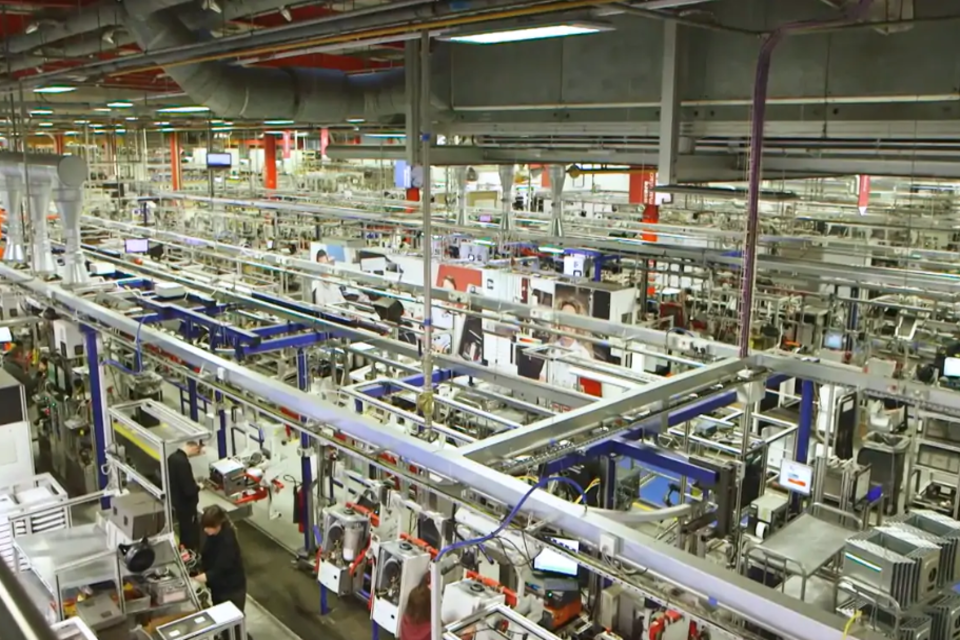Worcestershire 5G Consortium
This project explored ways to increase productivity by using robotics, big data analytics and augmented reality with 5G in a manufacturing setting.

Worcestershire 5G Testbed
Led by a team of 5G and Industry 4.0 experts, the Worcestershire 5G Testbed provided a platform for UK industry to develop and test next-generation technology that could revolutionise the way businesses operate in the future. The Worcestershire 5G Consortium, based at Malvern Hills Science Park, explored the feasibility of a range of use cases including possible ways to increase productivity through early machine fault detection using robotics, remote training, and ‘security by design’ at the Worcester Bosch factory.
Key findings

- In February 2019, the project ran its first 5G industrial trial at the Worcester Bosh factory after successfully installing its 5G kit in a factory.
- In 2019, the project published its 5G Skills Report, providing key insights into the 5G skills shortages in the UK and outlining potential steps to tackle this gap.
- Initial evidence collected indicated that the technology could work at the level needed to achieve productivity gains in a factory setting, but no actual productivity savings were demonstrated during the period of the trial.
- We are exploring new and similar use cases in other industrial and manufacturing projects in 5G Factory of the Future, 5G Encode and 5GEM to provide stronger evidence and will share updates on the findings from these as it comes in.
Use cases
-
Condition-based maintenance on machines:
- Spindle preventative maintenance allows sensors to monitor a machine in a factory in real time. Through 5G’s low latency and ability to process large amounts of data, it can provide a real-time analysis of a machines’ status and feed live data to the factory’s cloud system.
- The period of the trial allowed feasibility testing of the sensors on the network, showing they would be good enough, but no actual preventative maintenance savings were demonstrated during the period of the trial.
- Engineers were given Augmented Reality (AR) headsets connected via 5G to see if they could be used to carry out maintenance on a machine on Bosch’s premises as part of their remote training, while speaking to an engineer in a separate remote location, providing them instructructions. This could reduce customer down time and reduce service and warranty costs.
- The testing showed that the headsets worked well on the network but no live maintenance was carried out during the period of the trial.
- Spindle preventative maintenance allows sensors to monitor a machine in a factory in real time. Through 5G’s low latency and ability to process large amounts of data, it can provide a real-time analysis of a machines’ status and feed live data to the factory’s cloud system.
- Robotics Video Monitoring: High quality video monitoring allowed engineers to remotely monitor any machine in the factory. Engineers could be provided a live video feed which can help them identify any changes to the machine and quality of the products being produced. This could help plan repairs during downtime or monitor machines. Again the cameras were shown to be operating effectively but no savings were demonstrated during the period of the project.
- Assisted Maintenance: Engineers received real time data and information allowed them to detect any changes in the machines and identify any early warning signals that could cause the machine to break down. As above, sensors provided information at the appropriate speed and level of detail, but no actual savings were evidenced as part of this trial.
- Research was carried out as part of this trial looking at ways of ensuring top levels of security were in place in the factory context.
- The project has launched a subsidiary company, nexGworx, to continue the work on smart manufacturing and digital innovation.
Reports
- Worcestershire 5G Testbeds and Trials Final Report - Final report outlining the project’s aims, benefits and use case analysis.
- Worcestershire 5G Skills Report - Report providing insights into the 5G skills shortages in the UK and potential steps on who to tackle the 5G skills gap.
Project partners
- Worcestershire Local Enterprise Partnership (Lead)
- O2
- BT
- Bosch
- AWTG
- 5G Innovation Centre, University of Surrey
- Yamazaki Mazak (Japanese machine tool manufacturer)
- QinetiQ (defence company, providing assurances on the ‘security by design’ of 5G/IoT)
- Malvern Hills Science Park
More information on the project can be found here.
Updates to this page
Published 23 July 2018Last updated 2 August 2021 + show all updates
-
Updated case study
-
First published.